Can SEBI Clear The Murky Waters Of Finfluencers In India?

Like pretty much anyone in the world, Indians find it hard to resist a get-rich-quick plan. From the grand scam of 1992 aka the Harshad Mehta saga to today’s crypto scams and everything in between — the lure of money continues to attract people who have little exposure to the dark side.
Perhaps most unfortunately, unsavoury tactics of investment advisors, scams and confidence schemes see a resurgence amid economic slowdowns since that is when money is tightest.
Of course, the modus operandi of self-proclaimed investment gurus who promise to give multifold returns quickly has changed.
Today, the investment advisory space is filled with ‘financial gurus,’ commonly known as ‘furus,’ and ‘finance influencers,’ also known as ‘finfluencers.
These new-age investment evangelists dominate conversations on social media around the best stocks, the best assets and maximising wealth. It all starts with offering some nuggets of wisdom and a couple of interesting insights to followers and as these numbers grow, the tactics grow more vicious.
Of course, there’s a lot of valuable financial content out there and nothing can be said to be illegal when done for free on social media, or when expertise is not claimed.
But in recent months, finfluencers have been accused of peddling misinformation to push stocks where they have vested interests, besides allegations of kickbacks from companies for promoting their stocks, manipulating investors with fake proof of growth and even charging ordinary individuals for these advisory services.
These ‘experts’ often mandate users to buy premium memberships, courses, software and services to ‘help’ them (the young and the uninitiated) time the market and make money. Interestingly, most of them are not registered investment advisors (RIA) or research analysts with the Securities and Exchange Board of India (SEBI), the capital market regulator.
This raises concerns about the legality of their operations. Persuasive sales pitches have seemingly convinced people, especially during and after the Covid years, when ‘online’ became the way to live and grow. Social media engagement skyrocketed and the creator economy boomed like never before. Now, as the impact of COVID recedes, creators are being called out for these shady tactics.
Even though SEBI has penalised several such influencers, these fines have only targeted only a few finfluencers and investment advisors. There’s an entire underbelly that operates under this radar.
More importantly, will there be a core initiative to raise financial literacy nationwide so that made-easy market solutions are no longer sought from dubious ‘experts’?
The Ravisutanjani Story: Another Finfluencer Bites The Dust
In September, the attention of startup social media turned to Ravisutanjani Kumar, who had over 1.25 Lakh followers on X (Twitter) but quit the platform after many of his claims and accolades were exposed by an anonymous X handle and then questioned by several others.
The allegation was that Kumar landed jobs at major startups with fake educational qualifications and also a living as an influencer. Kumar responded the next day claiming he had been harassed and targeted by social media users, and proceeded to delete his Twitter and LinkedIn accounts.
A noted influencer before this, Kumar shot to fame for his timely and consistent tweets on everything to do with Indian tech, startups (fintech primarily), founders as well as the economy or new policies. His tweets were even retweeted by PM Narendra Modi at one point, which gave him quite a lot of clout online, and Kumar seemingly leveraged this to a certain extent.
For instance, on creator platform TopMate, Kumar charged individuals INR 250 to INR 25,000 for services such as consulting, mentoring, brand building, etc.
Now, many are left wondering what this means for anyone who has contributed to Kumar’s income, even some users who have paid for his courses on online platforms. There are questions about how such ‘influencers’ should be dealt with legally, and whether regulations need to be brought in to check such behaviour.
What’s the harm in faking degrees on social media, one may ask, and there is none, except when that claim is used to earn money from unsuspecting individuals.
The biggest problem of course is that the trust is broken. Kumar’s was not an isolated case. He is one of the many finfluencers who have created an illusion around their expertise that does not stand scrutiny. All this to grow social media followers and earn money through this base.
Without the illusion of their expertise and insights, not many would have been willing to pay the consultancy fee Kumar used to get. Such incidents continue to expose the rampant deception prevalent in the finfluencer community.
Another curious case involves YouTuber and finfluencer Abhishek Kar, who was exposed by Shreyas Bandi (@BandiShreyas) and others on social media on August 29. Kar was alleged to have induced people into trading in stocks without any approvals from SEBI. Additionally, he is said to have charged fees ranging from INR 10K to 14K for his courses.

The premium memberships promised higher profits and proudly showcased his ‘success’ stories. In reality, he had incurred losses in the Futures and Options (F&O) market in FY21 and FY22 but concealed this from his 1.5 Mn followers. Sadly, caught up in the quick money schemes, investors paid scant attention to hygiene checks and joined Kar’s game of high-risk trading.
Finfluencers Make Hay On Social Media
Where once companies offered formal investment advisory services, today’s finfluencers typically engage with their audience via informal platforms such as X, or even WhatsApp and Telegram.
According to SEBI data, India has 1,300+ registered investment advisors catering to 80 Mn+ investors. But unregistered finfluencers have grabbed the limelight as well.
The game is simple: make content around investment advice and claim to help followers make informed decisions regarding wealth management and their financial goals. But it’s how they go about it that becomes problematic.
Meenakshi Srikanth, cofounder of SEBI-registered wealth consultancy PrimeInvestor, says the bad apples in this lot have certain red flags that one can watch out for.
While credible investment advisors dedicate their time, energy and analytical prowess to create meaningful content, they primarily earn through ad revenue, content fees and consultation fees.
In contrast, the ‘bad’ finfluencers pretend to provide expert advice but often provide incorrect or useless tips. They also charge exorbitant fees for simple advice and misuse their influence to earn huge profits not in sync with the value they deliver. Regulators must keep tabs on these entities and their practices to safeguard investors, Srikanth said.
But as we can see, unauthorised finfluencers still have massive following and eye-popping income.
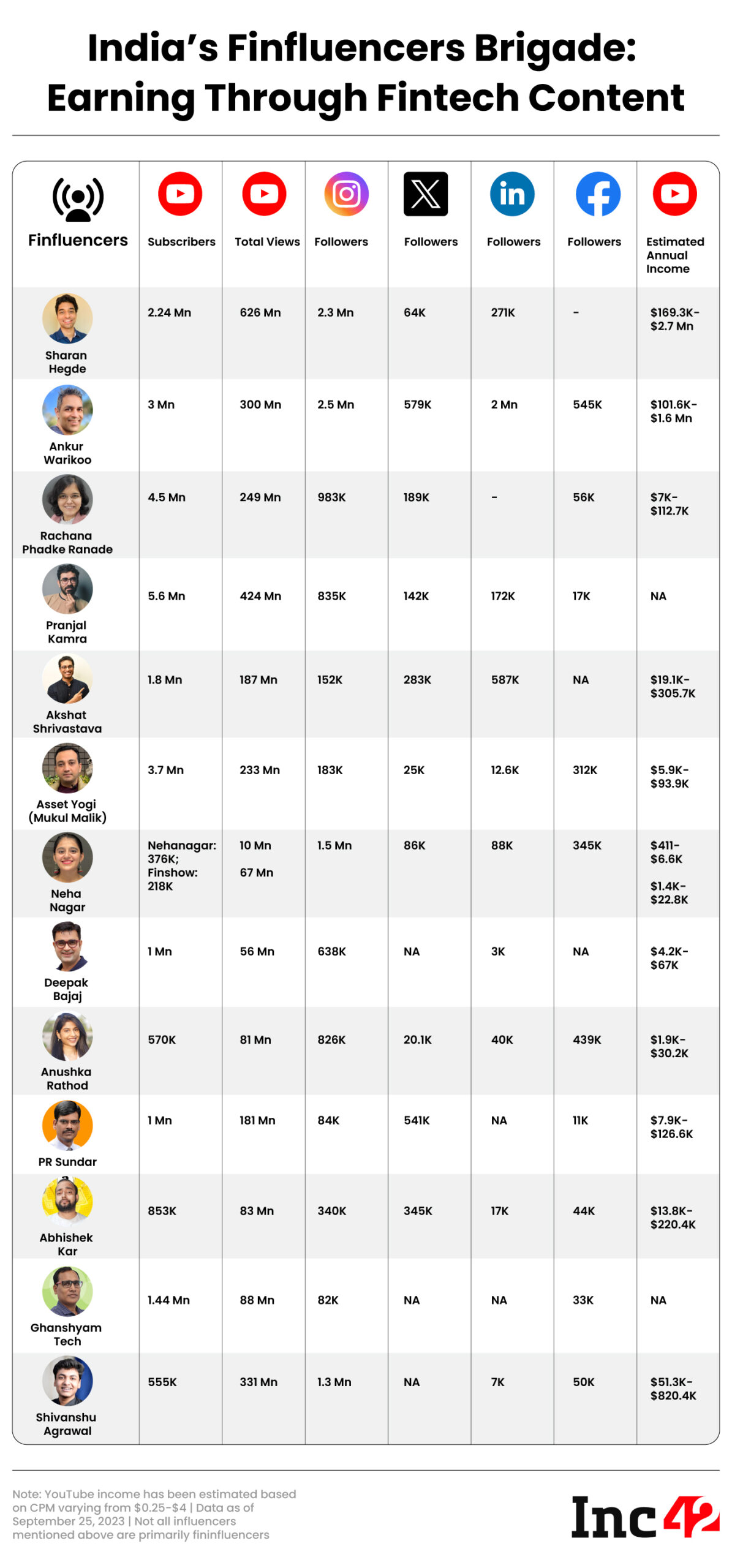
It is not difficult to understand the income streams for these finfluencers. They make money through unique products and services, brand promotions and partnerships, as well as ad viewership on platforms like YouTube.
Content type, number of followers/subscribers, engagement rate and other factors also add to the revenue stream. Here are the three major sources of income:
- Products and services: Earnings through premium memberships and courses, seminars, webinars, events and consultancy, with fees ranging from INR 1K to INR 25K
- Brand partnerships and promotions: Many finfluencers partner with brands to endorse their products and services. The bigger creators can charge between INR 5 Lakh and INR 10 Lakh per social media post, while those with fewer followers and less impact may charge as low as INR 10K per post.
- Social media engagement: Several social media platforms pay content creators based on CPM/cost per mille (per 1K views), while others reward them based on different parameters.
In many cases, the nature of the creator economy forces finfluencers to use deception. For instance, advertisers on YouTube typically do not like to pay money to bid on sponsored videos. This greatly limits the revenue potential of a creator, but only if they disclose the content as promoted content or being sponsored.
“Youtube advertisers don’t like to place ads within branded content. As a result, ad revenue on a branded or sponsored video gets reduced by over 70%. This is why, most of the influencers try to create branded content in a way that could confuse YouTube and don’t declare their content as sponsored, paid or promotions,” one finfluencer told Inc42.
So, how exactly do finfluencers confuse YouTube that the particular video is not a promotional video despite the fact that it is?
By de-influencing as one of the means where finfluencers are paid to criticize the competition. And, finfluencers present the same as research and analysis, or as their opinion.
Speaking to Inc42, Manisha Kapoor, CEO and secretary general of ASCI said that de-influencing, when social media influencers advise against buying certain things or endorsing specific brands, brings up ethical concerns. It’s important for finfluencers to be honest and clear about their reasons. They should refrain from causing problems for businesses and aim to provide advice that helps people make better choices.
“They also need to be responsible and not confuse their followers. Being fair, respectful, and considering the impact on society and the environment are part of ethical de-influencing. The goal is to help people buy wisely while being honest and fair,” Kapoor added.
Faking Leads To Moolah
In many cases, finfluencers are simply doing what Ravisutanjani Kumar once tweeted: Fake it till you make it. The tweet is currently unretrievable but it’s unfortunate and ironic nonetheless.
Ankur Warikoo, quite a household name and often considered one of the most popular finfluencers, has also faced allegations of spreading misinformation for profit. In 2022, while promoting crypto investments in the now-failed exchange Vauld, he made two critical remarks: It is guaranteed and There is no risk involved.

Then again, Warikoo was caught promoting health products on X without a proper disclaimer, breaching the guidelines that require adequate qualifications before such endorsements. When a medical doctor called him out, he issued an apology but failed to add a clear disclaimer.
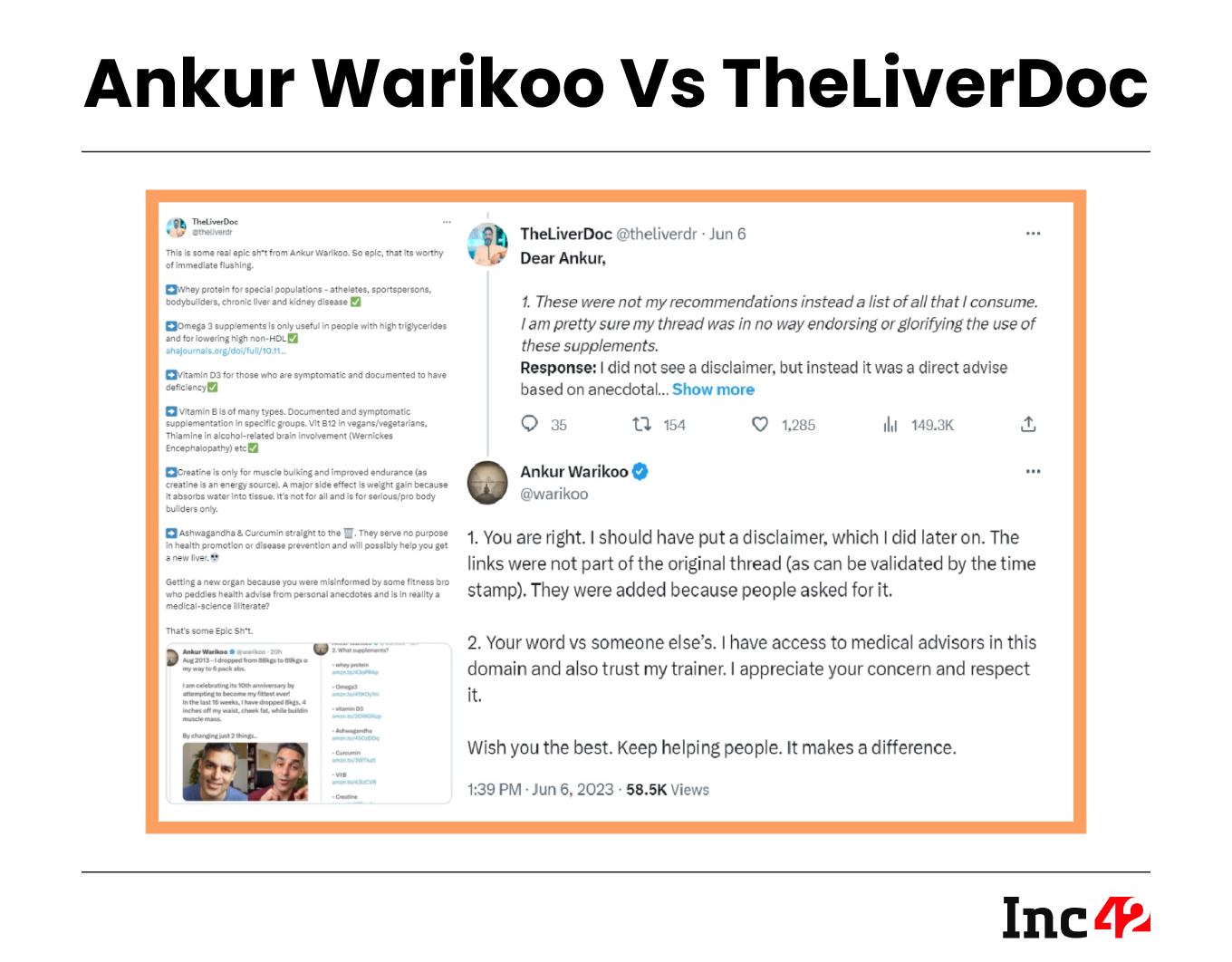 He was also involved in promotions for the World Startup Convention, which proved to be a sham funding festival targeting unsuspecting young founders.
He was also involved in promotions for the World Startup Convention, which proved to be a sham funding festival targeting unsuspecting young founders.
Readers have also accused him of copying content from The Psychology of Money by Morgan Housel and The Almanack of Naval Ravikant by Eric Jorgenson.
Similarly, Akshay Shrivastava drew flak for posting misleading content on social media. Another finfluencer Subhadip Nandy is accused of offering expert and investment-related advice through his paid workshops as well as other platforms. Both Nandy and Shrivastava are not registered with SEBI.
Despite their gravity, these alleged offences pale before fake profit and loss (P&L) statements or unauthorised investment advice which directly violate SEBI guidelines for individual, non-individual investment advisors.
But it would seem that many of these finfluencers just don’t care about meeting these mandatory compliances.
Is SEBI Reining In Finfluencers?
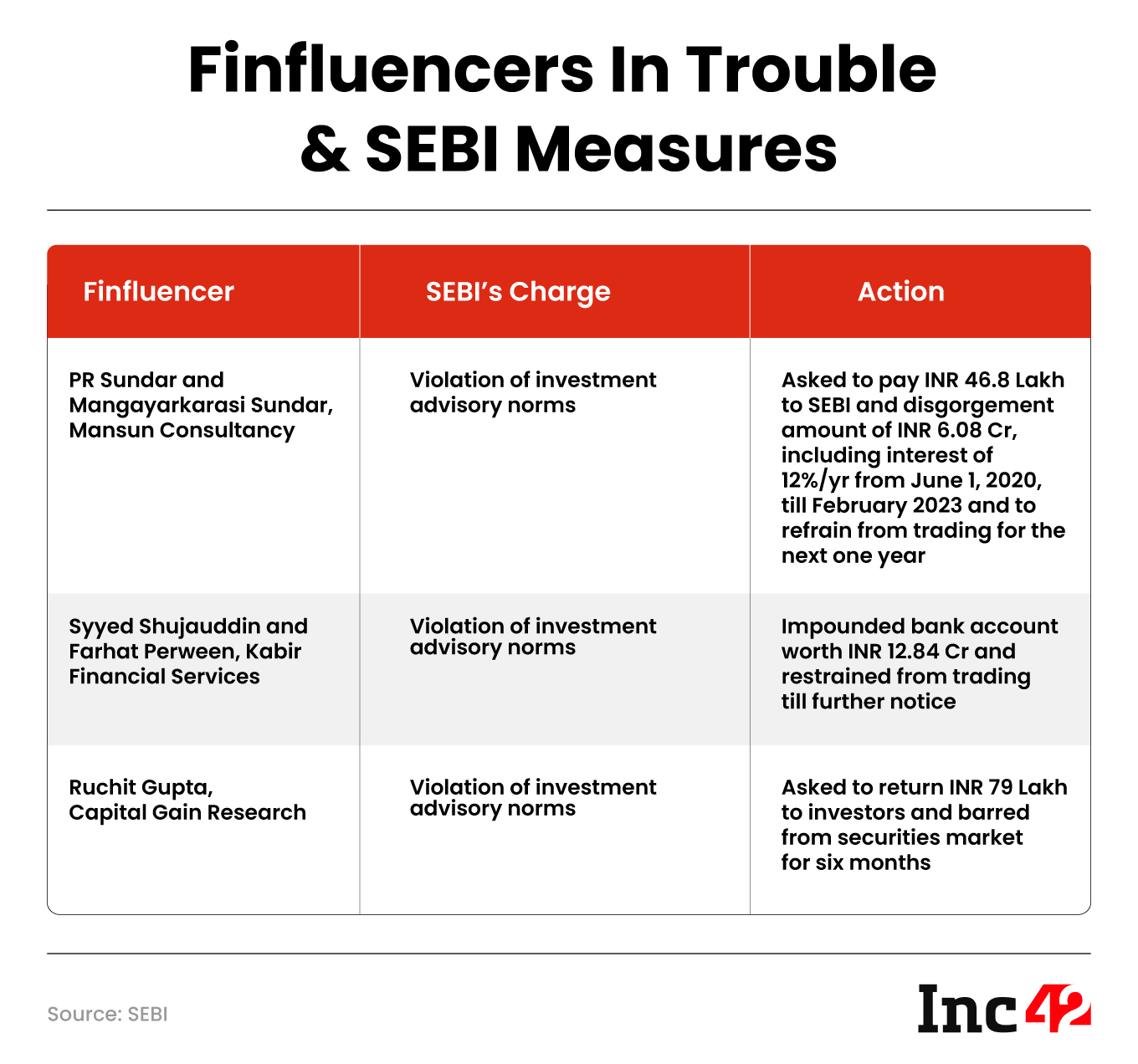
Earlier this year, SEBI took action against some finfluencers, including big names such as PR Sundar, Syyed Shujauddin and Ruchit Gupta. Others could soon also be on its radar, as allegations regarding faked P&L claims and other dubious tactics have surfaced.
In May, SEBI penalised PR Sundar, stating that his website offered investment advisory services without SEBI registration since 2013. He was ordered to pay INR 46.8 lakh to SEBI as a settlement and INR 6.07 crore to clients and investors as disgorgement, including a 12% yearly interest to be returned to customers based on the fees they paid. He was also banned from dealing in the securities market for one year.
Gupta, proprietor of Capital Gain Research, was ordered to return INR 79 Lakh in May to investors and barred from accessing the securities market for six months.
In June 2023, SEBI issued an interim order against husband-wife duo Shujauddin and Farhat Perween of Kabir Financial Services for running an unregistered investment advisory firm on Telegram. The regulator impounded their bank accounts and prohibited them from offering investment advisory services.
Although SEBI has not penalised many finfluencers or investment advisory firms, the market watchdog has received numerous complaints about non-compliance since 2022 and is said to be investigating those cases. This has caused consternation and concern in the finfluencer world.
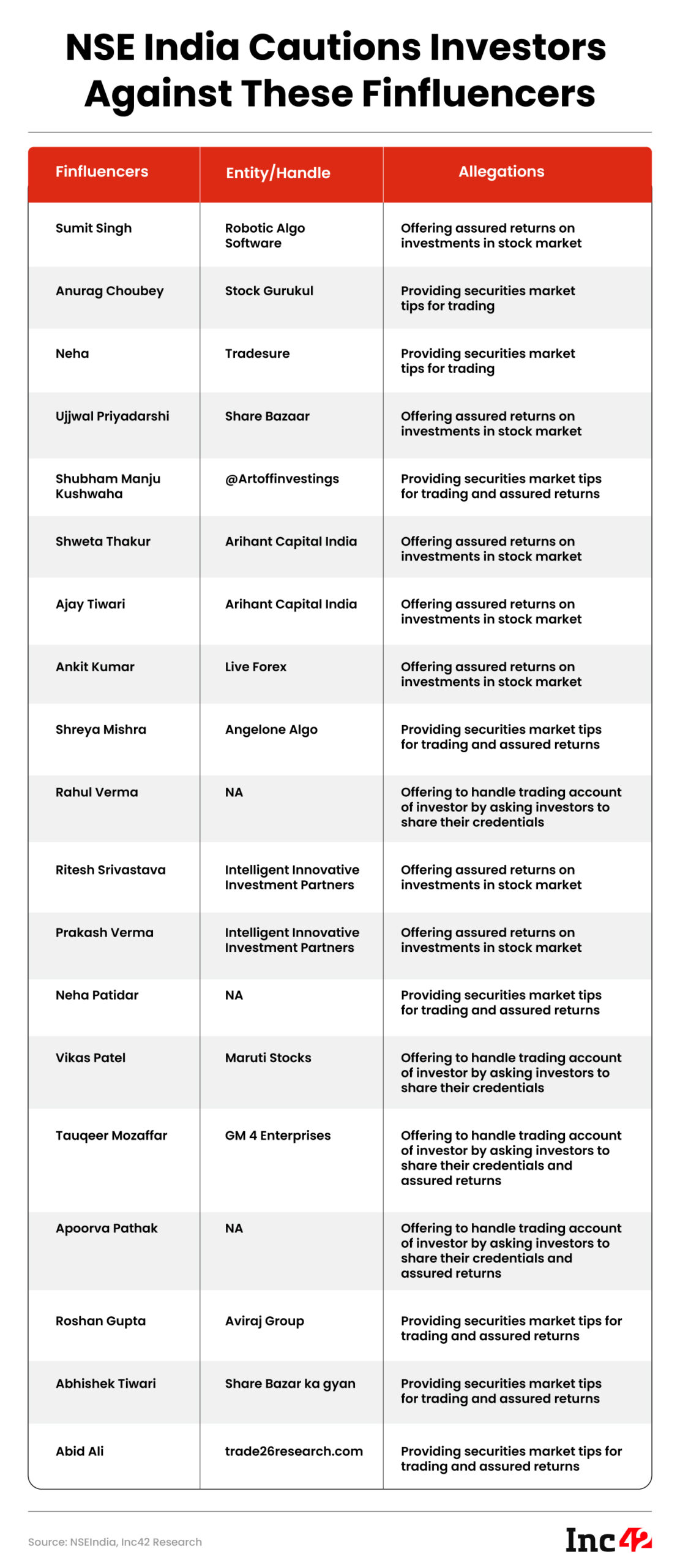
Besides, NSE India has published cautionary notes for investors against dozens of finfluencers. Since most of these finfluencers operate WhatsApp and Telegram channels and ask investors to pay via UPI, NSE India has also published their mobile numbers.
Scrolling through the most popular finfluencer websites and social media handles, we have found that dozens of finfluencers deleted content from the past few months. Some have even deleted ‘trading’ courses, one of their key revenue streams.
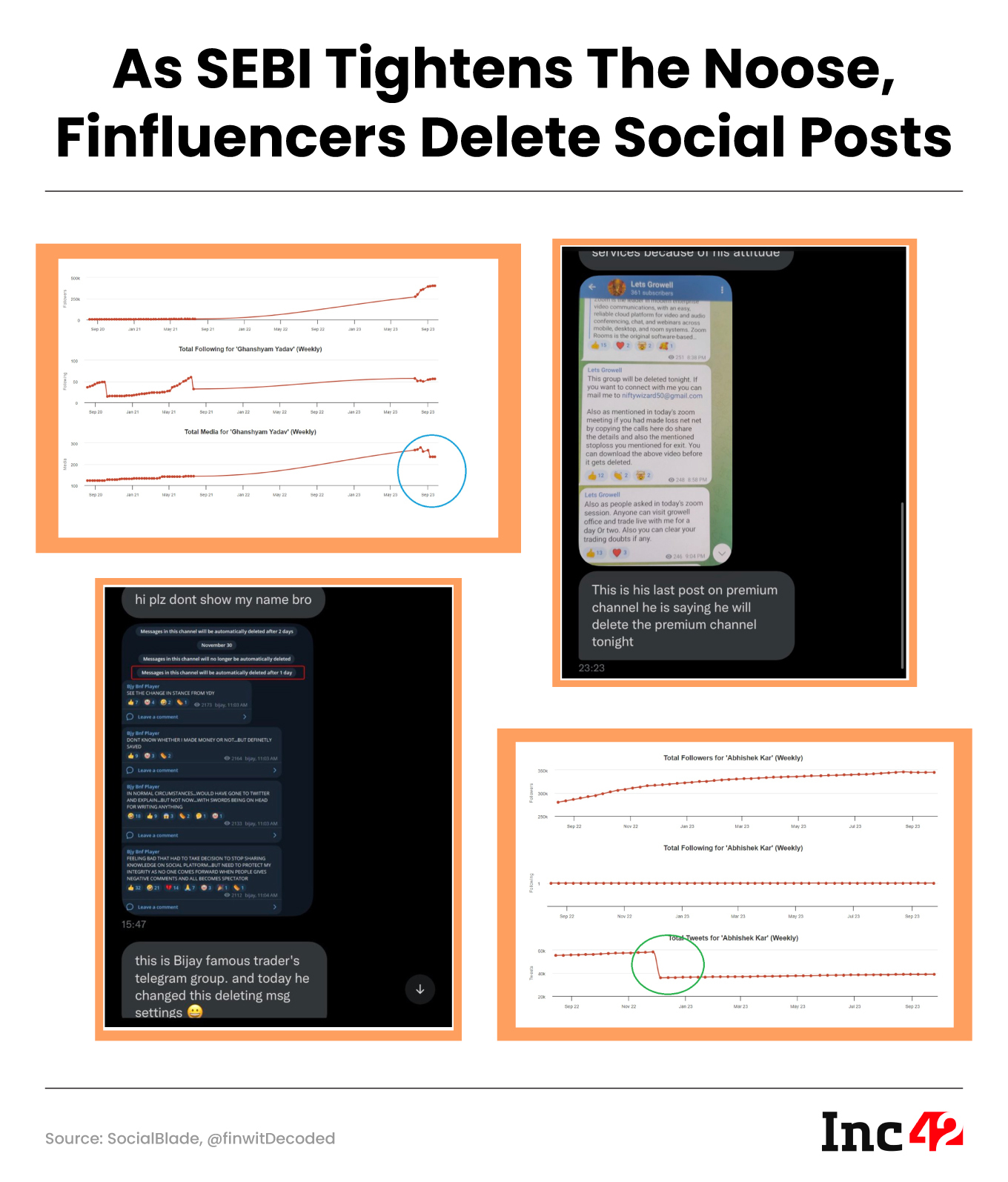
Consider this: between November 27 and December 5, 2022, when many investors and traders demanded that finfluencers post accurate data, Abhishek Kar deleted more than 22K tweets, many related to his paid membership plans called AK Charts Premium.
Understandably, many of these tweets covertly offered stock advice despite no SEBI approvals.
Ghanshyam Tech (Yadav), another finfluencer with more than 403K followers on Instagram and 1.44 Mn on YouTube, removed over 35 Insta posts between August 9 and September 9, 2023. Like Kar, he is also accused of faking P&L statements to lure investors into investing in specific stocks.
Multiple finfluencers who were running paid telegram channels have deleted either their channels or their contents from their channels.
With SEBI taking cognizance of the finfluencer issue, cautious advisors are now adding disclaimers to their content. These disclaimers state that they are neither SEBI-registered advisors nor research analysts, and that the content does not constitute investment advice.
Supporting the need for regulation, in August 2023, finfluencer Akshat Shrivastava tweeted, “As a finance educator, I am fully supportive of SEBI’s regulation. If they require me to take an exam or disclose my audited P&L, I am willing to comply. My request is that mainstream media, where discussions on stocks and other financial products are common, should also be subject to the same standards and scrutiny.
Educated and competent individuals with nothing to hide should not fear this. This should apply to everyone. Furthermore, the process of obtaining a SEBI license should be made more streamlined and simplified.”
According to Deepank Singhal, an entertainment and media lawyer and an IP attorney, the current context involves two major roles: research analysts and investment advisors. Both must be registered with SEBI so that the regulator can swiftly and effectively address all market malpractices.
SEBI-registered analysts or advisors must also adhere to SEBI’s mandated advertising guidelines. However, the same does not apply to finfluencers as of yet. It is, therefore, imperative for SEBI to promptly extend and implement these regulations to finfluencers, especially in light of the recently published consultation paper, Singhal said.
It’s worth noting that both major stock exchanges in India, namely BSE and NSE, have mandated that any advertisement issued by stockbrokers or authorized individuals/partners in association with influencers/bloggers must receive prior approval. Interestingly, these exchanges have equated influencers with over 1 Mn followers on social media platforms to celebrities while restricting them from advertising for such stockbrokers or members.
“Needless to say, SEBI must urgently take action to shut down such WhatsApp/Telegram groups that unlawfully engage in disseminating unverified information and influencing the financial decisions of their members/followers, by initiating appropriate legal actions. Furthermore, social media companies must cooperate with authorities in revealing the identities of the administrators of such groups for effective enforcement,” Singhal added.
In late August 2023, SEBI released a consultation paper aimed at curbing the mis-selling of financial products. The paper targets potential manipulation by individuals faking their credentials or having other vested interests.
Some proposed measures include prohibiting regulated entities and individuals from having any form of association with unregulated finfluencers, ensuring client data confidentiality and mandatory disclosures by registered finfluencers. The regulator also aims to disrupt the revenue model of unregistered finfluencers to mitigate the perverse incentives within the ecosystem.
Even the Advertising Standards Council of India (ASCI) revised its guidelines for finfluencers, making it mandatory for them to be registered with SEBI to offer investment-related advice.
Manisha Kapoor of ASCI, said that the guidelines are applicable to all industry stakeholders. “With potential risks linked with misleading and deceptive advertising content within critical sectors like BFSI. To safeguard consumers from financial harm, finfluencers providing advice must have the necessary qualifications and certifications to provide such information and advice to consumers,” Kapoor added.
Watching The Finfluencers
BFSI players believe it is crucial for regulatory bodies to take proactive steps.
Prabhakar Tiwari, chief growth officer of the stock broking platform Angel One, told Inc42, “Our approach also involves implementing more robust digital monitoring systems and ensuring that individuals are not unduly penalized for their ignorance, particularly when not acting deliberately. While the establishment and fine-tuning of these measures might require time, they are crucial for the sustained well-being of our ecosystem.”
But the big question is: How to proactively monitor finfluencer content created at scale across social platforms?
According to ASCI’s Kapoor, the sheer number of ads and short campaigns make it difficult to monitor all content. One in four finfluencer ads reviewed had violations in FY23, while digital advertising accounted for 55% of these violations in FY22.
“ASCI has implemented a robust AI-powered platform specifically designed for monitoring influencers in the digital media space, which now accounts for 80% of the complaints addressed by ASCI,” she added.
Additionally, the digital trail helps distinguish between legitimate and manipulative activities. As this issue has become mainstream, responsible players take proactive steps to implement investment safeguards. Not all players are transparent yet, but this is expected to change soon.
The rising awareness among investors also makes them aware of the risks associated with seeking advice from unqualified/unregistered investment advisors. Should SEBI go full throttle to monitor and manage finfluencers and their channels?
PrimeInvestor’s Srikanth believes that achieving 100% compliance may not be feasible. However, if SEBI can make a difference in just 20% of the cases, it can still have a significant impact.
[Edited by Sanghamitra Mandal]
The post Can SEBI Clear The Murky Waters Of Finfluencers In India? appeared first on Inc42 Media.
No comments